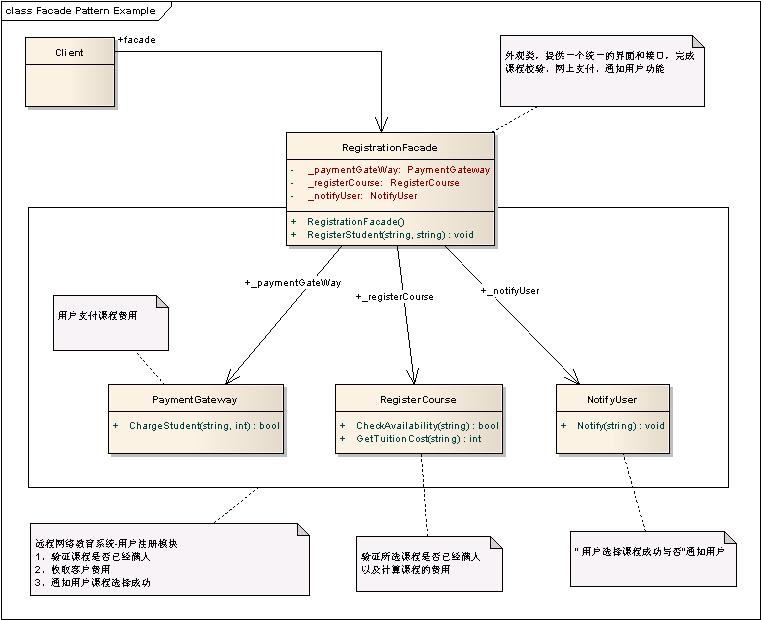本文将介绍的是外观模式,也就是.NET设计模式中的一种。在这里希望通过本文,能让大家对.NET设计模式有进一步的了解,同时也提供了相应代码实例供大家参考。
#T#
一、外观模式简介(Brief Introduction)
外观模式,为子系统的一组接口提供一个统一的界面,此模式定义了一个高层接口,这一个高层接口使的子系统更加容易使用。
二、解决的问题(What To Solve)
1、分离不同的两个层
典型的分层例子是Net三层架构,界面层与业务逻辑层分离,业务逻辑层与数据访问层分类。这样可以为子系统提供统一的界面和接口,降低了系统的耦合性。
2、减少依赖
随着功能增加及程序的重构,系统会变得越来越复杂,这时增加一个外观可以提供一个简单的接口,减少他们之间的依赖。
3、为新旧系统交互提供接口
有的时候,新系统需要旧系统的核心功能,而这个旧的系统已经很难维护和扩展,可以给新系统增加一个Façade类,是的新系统与Façade类交互,Façade类与旧系统交互素有复杂的工作。
三、外观模式分析(Analysis)
1、外观模式结构

2、源代码
1、子系统类SubSystemOne
- public class SubSystemOne
- {
- public void MethodOne()
- {
- Console.WriteLine("执行子系统One中的方法One");
- }
- }
2、子系统类SubSystemTwo
- public class SubSystemTwo
- {
- public void MethodTwo()
- {
- Console.WriteLine("执行子系统Two中的方法Two");
- }
- }
3、子系统类SubSystemThree
- public class SubSystemThree
- {
- public void MethodThree()
- {
- Console.WriteLine("执行子系统Three中的方法Three");
- }
- }
4、Facade 外观类,为子系统类集合提供更高层次的接口和一致的界面
- public class Facade
- {
- SubSystemOne one;
- SubSystemTwo two;
- SubSystemThree three;
- public Facade()
- {
- one = new SubSystemOne();
- two = new SubSystemTwo();
- three = new SubSystemThree();
- }
- public void MethodA()
- {
- Console.WriteLine("开始执行外观模式中的方法A");
- one.MethodOne();
- two.MethodTwo();
- Console.WriteLine("外观模式中的方法A执行结束");
- Console.WriteLine("---------------------------");
- }
- public void MethodB()
- {
- Console.WriteLine("开始执行外观模式中的方法B");
- two.MethodTwo();
- three.MethodThree();
- Console.WriteLine("外观模式中的方法B执行结束");
- }
- }
5、客户端代码
- static void Main(string[] args)
- {
- Facade facade = new Facade();
- facade.MethodA();
- facade.MethodB();
- Console.Read();
- }
3、程序运行结果

四.案例分析(Example)
1、场景
假设远程网络教育系统-用户注册模块包括功能有
1、验证课程是否已经满人
2、收取客户费用
3、通知用户课程选择成功
如下图所示

子系统类集合包括:PaymentGateway类、RegisterCourse类、NotifyUser类
PaymentGateway类:用户支付课程费用
RegisterCourse类:验证所选课程是否已经满人以及计算课程的费用
NotifyUser类:" 用户选择课程成功与否"通知用户
RegistrationFacade类:外观类,提供一个统一的界面和接口,完成课程校验、网上支付、通知用户功能
2、代码
1、子系统类集合
- namespace FacadePattern
- {
- /// <summary>
- /// Subsystem for making financial transactions
- /// </summary>
- public class PaymentGateway
- {
- public bool ChargeStudent(string studentName, int costTuition)
- {
- //Charge the student
- Console.WriteLine(String.Format("Charging student {0} for ${1}", studentName, costTuition.ToString()));
- return true;
- }
- }
- /// <summary>
- /// Subsystem for registration of courses
- /// </summary>
- public class RegisterCourse
- {
- public bool CheckAvailability(string courseCode)
- {
- //Verify if the course is available..
- Console.WriteLine(String.Format("Verifying availability of seats for the course : {0}", courseCode));
- return true;
- }
- public int GetTuitionCost(string courseCode)
- {
- //Get the cost of tuition
- return 1000;
- }
- }
- /// <summary>
- /// Subsystem for Notifying users
- /// </summary>
- public class NotifyUser
- {
- public bool Notify(string studentName)
- {
- //Get the name of the instructor based on Course Code
- //Notify the instructor
- Console.WriteLine("Notifying Instructor about new enrollment");
- return true;
- }
- }
- }
2、外观类Façade Class
- /// <summary>
- /// The Facade class that simplifies executing methods
- in the subsystems and hides implementation for the client
- /// </summary>
- public class RegistrationFacade
- {
- private PaymentGateway _paymentGateWay;
- private RegisterCourse _registerCourse;
- private NotifyUser _notifyUser;
- public RegistrationFacade()
- {
- _paymentGateWay = new PaymentGateway();
- _registerCourse = new RegisterCourse();
- _notifyUser = new NotifyUser();
- }
- public bool RegisterStudent(string courseCode, string studentName)
- {
- //Step 1: Verify if there are available seats
- if (!_registerCourse.CheckAvailability(courseCode))
- return false;
- //Step 2: Charge the student for tuition
- if (!_paymentGateWay.ChargeStudent(studentName, _registerCourse.GetTuitionCost(courseCode)))
- return false;
- //Step 3: If everything's successful so far, notify the instructor of the new registration
- return _notifyUser.Notify(studentName);
3、客户端代码
- namespace FacadePattern
- {
- class Program
- {
- static void Main(string[] args)
- {
- RegistrationFacade registrationFacade = new RegistrationFacade();
- if (registrationFacade.RegisterStudent("DesignPatterns101", "Jane Doe"))
- Console.WriteLine("Student Registration SUCCESSFUL!");
- else
- Console.WriteLine("Student Registration Unsuccessful");
- }
- }
- }
五、总结(Summary)
外观模式,为子系统的一组接口提供一个统一的界面,此模式定义了一个高层接口,这一个高层接口使的子系统更加容易使用。
外观模式可以解决层结构分离、降低系统耦合度和为新旧系统交互提供接口功能。
原文标题:Net设计模式实例之外观模式(Façade Pattern)
链接:http://www.cnblogs.com/ywqu/archive/2010/01/20/1652108.html

































